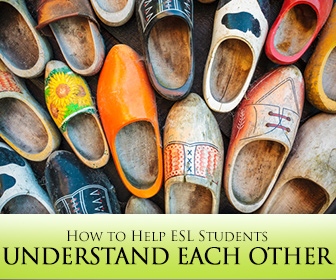Classroom Conflicts: How to Smooth Over a Cultural Clash


Not only do they speak a different language from you (and often from each other), they hold different cultural values. Culture, though it may seem easy to understand, is in fact a very complex and intimate part of who a person is. What makes culture more difficult to understand is that it permeates so much of who a person is without that person even realizing it. This activity is designed to help your students appreciate different cultures among the world’s people and to develop cultural sensitivity toward each other as well as the rest of the globe’s populations. Your students will be creating their own culture and the elements that are part of it and then sharing that culture with one another.

Before your students get creative with their own cultures, your class should take a look at the finer points of their own cultures. If you teach a class composed of the same nationality, you can use that nationality as your example. If you teach a class of internationals, use your own culture as the example, and then have them note the same points from their own cultures. Explain that culture comprises much of who we are without us even realizing it. Culture shows itself in our beliefs, our values, our habits, our expectations, our language, and our traditions among other things. Take a closer look at either your culture or your students’ culture by thinking about and noting specific elements on the board. Make a note of each of the following. I have used the USA as an example.
| Country/Nationality | USA/American |
| Language How to say the following words?
|
English |
| What do you do when you meet someone for the first time? What do you do when you meet someone you know? |
Shake hands Shake hands, hug, kiss |
| What do you say when someone sneezes? | God bless you |
| What are actions you should never do in your culture? (Cultural Taboos) | Show someone your middle finger or use it to point or do other actions, pick your nose or fart in public |
| What are some reasons you celebrate? | Birthdays, religious holidays, historical events, a personal accomplishment/success |
As you answer these questions with your class, encourage students to offer other examples they might know from their own or other cultures.
Once your students have an understanding of how culture manifests itself, it is time for them to create their own cultures. This is the scenario. Space exploration has reached a new height, and your country has discovered life on many other planets far from your solar system. These planets are small, and their populations are small as well. Though they are in close geographic proximity, they had no knowledge of each other’s existence until your country visited the planets. Your country is organizing an interplanetary conference where these peoples will meet each other for the first time. Each student’s task is to create a culture for one of those small planets.
Have students start by thinking up a name for their planet/culture and describing its geography as well as its people. Depending on your class, you might want them to illustrate the planet and people and display them around the room.
Once your students have created the planet, they should think more about the beings who live there by answering each of the following questions:
Once your students have answered these questions, have them go back to the questions you answered about your own culture and answer those questions about their fictional planet. Encourage students to be creative throughout the culture creation experience.
Once your students have developed their own cultures (and kept the information to themselves), it is time for all the people groups to meet. Half of the class will do the role play at a time while the other half watches. Have the students who are playing in the role play come to the front of the room. Each person will be acting as a person from the culture he created. In this part of the activity, the peoples are meeting each other in an informal atmosphere, like a party or mixer. They should perform their greetings, use their language and display other elements of the cultures they created. If someone from another culture performs one of the taboos, the person should act offended. Once the students have had enough time to meet and greet each other, have the groups change places and repeat the meeting.
After all your students have played the greeting, ask them about the experience. How did they feel when they were meeting people from other cultures? Were they uncomfortable at any point? Did anyone do anything that offended them? How did that feel? Did anyone do anything that made them feel welcome or happy? What was it? Encourage your students to share as many details about the experience as they are comfortable doing.
Then help your students understand why they had the experiences they did. Have pairs of students share the specifics about their cultures with each other. If possible, match students with someone who offended them in the meeting. As they discuss, each person should take notes about the other person’s created culture, listing the same information they have about their own culture. After students have shared, change the pairings and have students gather information about another culture.
Once students have gathered information about two other created cultures, come back together as a class. Ask students to share any insights they got learning the specifics about another culture. Then place students in groups of four or five for some discussion time. Give each group a copy of the following questions.
After students have discussed their experiences in both the class activity and real life, ask them to share their own experiences in writing. You might have them write a paragraph, an essay, a letter, a newspaper article, or something else. Individuals can use the discussion questions for inspiration, or they can write about their own ideas. Whatever they choose to write about, ask students to include a paragraph on what they learned from the entire experience.
They say it’s a small world after all, and that is truer every day. Helping your students understand each other and other peoples of the world does more than make your ESL class run smoothly. It helps them become globally sensitive people who can make a difference in the future of our world.
What do you do?